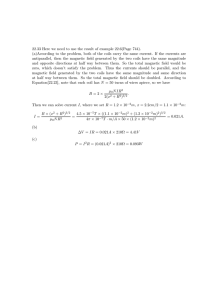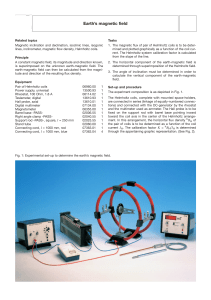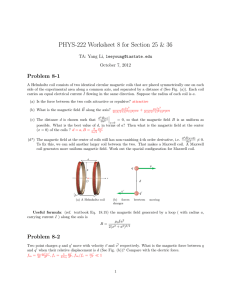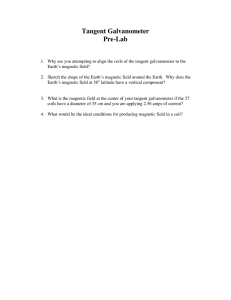LEP 4.3.01 Earth`s magnetic field
advertisement
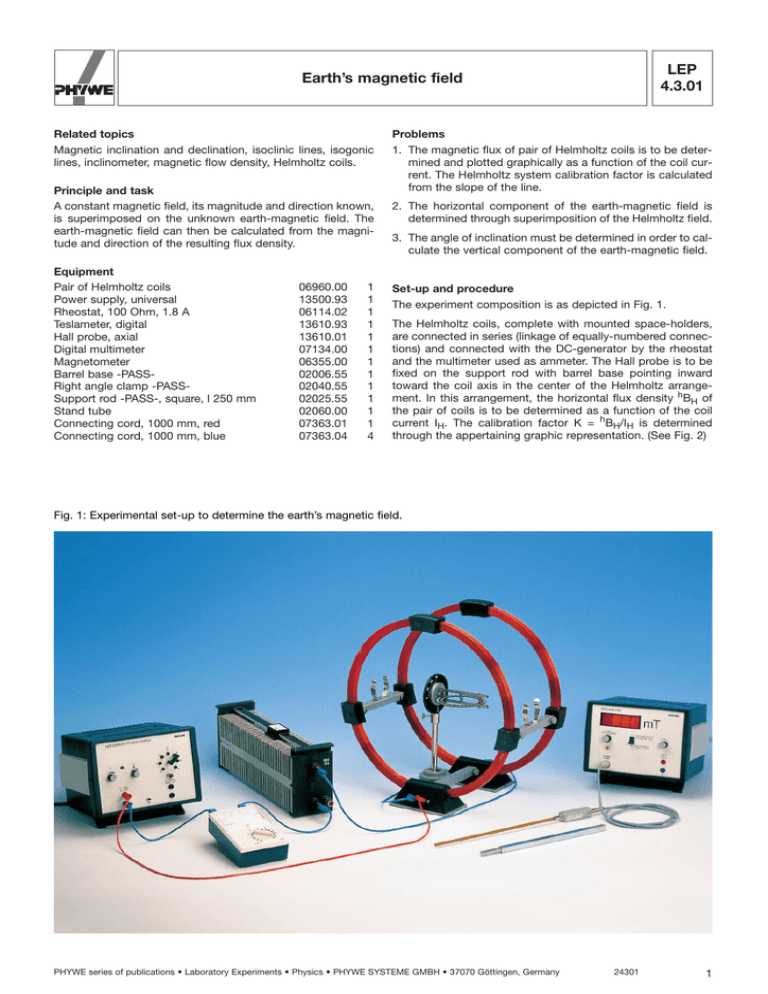
R LEP 4.3.01 Earth’s magnetic field Related topics Magnetic inclination and declination, isoclinic lines, isogonic lines, inclinometer, magnetic flow density, Helmholtz coils. Principle and task A constant magnetic field, its magnitude and direction known, is superimposed on the unknown earth-magnetic field. The earth-magnetic field can then be calculated from the magnitude and direction of the resulting flux density. Equipment Pair of Helmholtz coils Power supply, universal Rheostat, 100 Ohm, 1.8 A Teslameter, digital Hall probe, axial Digital multimeter Magnetometer Barrel base -PASSRight angle clamp -PASSSupport rod -PASS-, square, l 250 mm Stand tube Connecting cord, 1000 mm, red Connecting cord, 1000 mm, blue 06960.00 13500.93 06114.02 13610.93 13610.01 07134.00 06355.00 02006.55 02040.55 02025.55 02060.00 07363.01 07363.04 1 1 1 1 1 1 1 1 1 1 1 1 4 Problems 1. The magnetic flux of pair of Helmholtz coils is to be determined and plotted graphically as a function of the coil current. The Helmholtz system calibration factor is calculated from the slope of the line. 2. The horizontal component of the earth-magnetic field is determined through superimposition of the Helmholtz field. 3. The angle of inclination must be determined in order to calculate the vertical component of the earth-magnetic field. Set-up and procedure The experiment composition is as depicted in Fig. 1. The Helmholtz coils, complete with mounted space-holders, are connected in series (linkage of equally-numbered connections) and connected with the DC-generator by the rheostat and the multimeter used as ammeter. The Hall probe is to be fixed on the support rod with barrel base pointing inward toward the coil axis in the center of the Helmholtz arrangement. In this arrangement, the horizontal flux density hBH of the pair of coils is to be determined as a function of the coil current IH. The calibration factor K = hBH/IH is determined through the appertaining graphic representation. (See Fig. 2) Fig. 1: Experimental set-up to determine the earth’s magnetic field. PHYWE series of publications • Laboratory Experiments • Physics • PHYWE SYSTEME GMBH • 37070 Göttingen, Germany 24301 1 R LEP 4.3.01 Earth’s magnetic field Fig. 2: Calibration function of the pair of Helmholtz coils. Note: Before measuring begins, the zero-point position of the teslameter must be set precisely. Fig. 3: Vector diagram of the magnetic flux densities: A) Horizontal plane B) Vertical plane. Theory and evaluation For currentless coils, the magnetic needle of the magnetometer alligns itself with the horizontal component hBE (direction north/south”) of the earth-magnetic field. If an additional magnetic field hBH is superimposed on this component through the Helmholtz coils, the needle will be turned around the angle a and will point in the direction of the resulting hBR. In Fig. 3A), the field components for the general case w Þ 90° are represented. The components drawn by a broken line represent the resulting conditions of the polarity of the coil current is reversed. By means of the sine-theorem, we obtain: By means of barrel base, stand tube and optic judgement, the magnetometer (with a leveled graduated circle) is placed between the coils so that the center of the graduated circle is approximately identical with the center of the pair of coils. First, the direction “north/south” is noted on the graduated circle for currentless coils. In order to secure the direction “north/south” of the magnetic needle, the needle should be slightly turned away from its resting position several times. Possible friction resistance can be reduced by gently tapping the instrument. In order to determine the horizontal component hBE of the earth-magnetic field, the deflection angle a of the magnetic needle is measured from its resting position as a function of small coil currents. If the polarity of the coil current is reversed, the measuring series must be repeated. In determining the exact angle, the indications from both needle tips must be considered. The angle w (Fig. 3a) between the direction “north/south” and the axis of the pair of coils is obtained through maximal needle deflection when the resistor is short-circuited the ammeter eliminated and the coil current set to approximately 4 A. hB sin a sin a = = h H sin b sin ( w-a) BE (1) In the special case where the coil axis is perpendicular to the direction “north/south” (w = 90°), the following applies: BE = hBH cot a. h (2) By means of the calibration hB = IH · K (see Fig. 2) H (3) we get from (1): hB E · sin a = IH · K sin b (4) sin a If IH · K is represented as a function of sin b (Fig. 4), the horizontal component of the earth-magnetic field is obtained from the slope. hB E = 19.2 mT In conclusion, and for currentless coils, the graduated circle of the magnetometer is turned to the vertical plane so that the magnetic needle now indicates the inclination angle q1. Make sure that the spin axis is consistent with the direction “north/south”. In order to check on q2, the magnetometer is turned by 180° and thus replaced on the vertical plane. 2 24301 PHYWE series of publications • Laboratory Experiments • Physics • PHYWE SYSTEME GMBH • 37070 Göttingen, Germany R LEP 4.3.01 Earth’s magnetic field Fig. 4: Linear function according to (4) to determine the horizontal component hBE of the magnetic flux density of the earth-magnetic field. From Fig. 3 B) follows the vertical component VBE and the measured angle of inclination. q = 1 1 (q + q2) = (67° + 68°) = 67.5° 2 1 2 BE = HBE tan q = 46.3 mT V (5) The total flow density BE is calculated to * BE* = E(VBE)2 + (hBE)2 = 50.2 mT (6) Reference values for Göttingen: hB E VB E = 19.06 mT q = 66.57° BE = 47.91 mT = 43.96 mT Note: Acceptable measuring results are only obtainable if the influence of perturbing magnetic fields (for example: pieces of iron close to the measuring site) is avoided. PHYWE series of publications • Laboratory Experiments • Physics • PHYWE SYSTEME GMBH • 37070 Göttingen, Germany 24301 3
